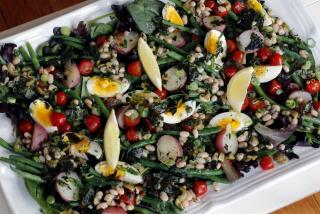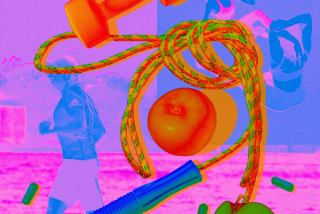Just Do It
- Share via
Most Americans know that the path to true health involves more exercise and good eating habits, but less than half are willing to go down that road.
The American Dietetic Assn. released its Nutrition Trends Survey last week with some surprising results, among them:
* Men are more interested in exercise than women.
* More than one in four Americans skip meals “quite a bit.”
* People are actually reading those nutritional labels on food.
The ADA-commissioned survey polled 823 adults nationwide. Similar surveys were conducted in 1995, 1993 and 1991. Here are some of the more striking findings from 1997:
Behaviors
* Thirty-nine percent of Americans say they are doing all they can to achieve a healthful diet, up from 35% in 1995, but down from a high of 44% in 1991.
* Women say they are doing all they can to eat healthfully, more so than men (42% versus 36%).
* Age is a significant factor in whether people do all they can to eat well--28% of 25- to 34-year-olds versus 55% of Americans 55 and older.
* Thirty-four percent of Americans say they are “careful in selecting what they eat to achieve a balanced diet.” This is consistent with past ADA trends-survey results.
* Forty-three percent of Americans say they made an effort to get regular physical activity or exercise; this reflects no change from 1995.
* The number of Americans who say they skip meals “very often” or “quite a bit” is 28%, up from 21% in 1995, suggesting this may be a growing trend.
* Until 1995, there was a gradual reported increase in the number of Americans who say they eat out frequently. This number stabilized in 1997 at 32%. Only 12% of Americans say they never eat out.
* More people (36%) say they are paying “only slight” or “no” attention to labels in 1997, compared with just two years ago (29%). There has been a drop in the number of Americans who say they “pay very close attention to labels,” down from 33% (1995) to 27%.
* Americans say labels impact their food-purchasing decisions: Based on labels, 69% say they buy some foods less often and 65% buy some foods more often. Fifty-nine percent say they eliminate items altogether based on labels, and 56% say they’ve switched to a different brand of the same item.
* Regional behaviors on physical activity levels differ: People in the West (50%) report they are most likely to make an effort to participate in regular physical activity, followed by people in the Midwest (43%), Northeast (42%) and South (39%). (Midwesterners report a substantial increase in regular exercise / activity, up from 22% in 1995.)
* Exercise is a greater concern to men (47%) than to women (40%).
Attitudes and beliefs
* Thirty-five percent of Americans believe vitamin supplements are necessary to ensure proper health. This represents an increase from prior surveys (28% in 1995, and 27% in 1993 and 1991).
* Women (40%) increasingly believe they need supplements to ensure proper health, up from 35% (1995) and 27% (1993). Women are more likely than men (30%) to believe they need supplements.
* People with less education (high school or less) are more likely (44%) to feel they need supplements to ensure proper health than college graduates, 29%.
* Most Americans (92%) believe fruits and vegetables to have “very healthful effects.” Other foods and food groups Americans view as very healthful include dried legumes (62%), grain foods such as pasta and bread (61%), fish (57%), poultry (55%) and dairy products (37%).
* Only 13% of Americans say they should eliminate all fat from their diets, down from a high of 17% in 1991. Those with less education (21%) tend to believe this more than the college-educated (8%).
* Eighty-one percent of Americans say exercise / physical activity is as important as a nutritious diet to good health. This is particularly true for African Americans (88%).
* Major perceived barriers to eating well include:
--40% don’t want to give up foods they like.
--39% are satisfied with the way they eat now.
--23% say studies are conflicting on food and nutrition issues.
-- 21% say it takes too much time to eat well.
* Dietitians and doctors are viewed as the most valuable source of food and nutrition information, both at 52%. This is particularly true for African Americans, who find doctors (72%) and dietitians (67%) to be “very valuable” nutrition sources.
* Seventy-two percent of respondents believe there are “good” and “bad” foods, reflecting a small, but steady decline in this belief from a high of 77% in 1991.
* Fifty-one percent of Americans say they like to hear about new studies, up from 43% in 1995.
Knowledge
* The top five ways Americans say they receive food and nutrition information are television, magazines, newspapers, family or friends, and books, the same as two years ago. Television has grown (57%) as Americans’ major source for nutrition information from 42% in 1995. Magazine and newspaper sources both had slight increases as well, from 39% to 44%, and 19% to 23%, respectively.
* Although television is the major source of nutrition information, it is judged as “very valuable” by only 24% of people. Americans rank dietitians or nutritionists (52%) and doctors (52%), followed by specialty magazines (39%) and women’s magazines (36%) to be the most valued sources of nutrition information.
* There has been a big increase in the awareness of the Food Guide Pyramid (67%), up from 58% in 1995.
* Forty-three percent of Americans aware of the Food Guide Pyramid rate it high in terms of usefulness in helping to select a balanced diet, up from 36% in 1995. Females (51%), more than males (32%), perceive the pyramid to be valuable.
*
Source: The American Dietetic Assn. 1997 Nutrition Survey was supported partly from a grant from the National Cattlemen’s Beef Assn.






